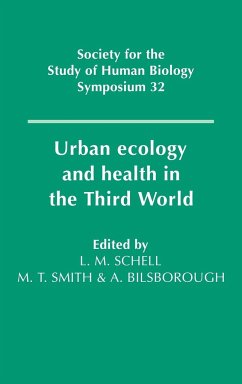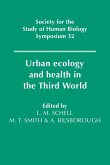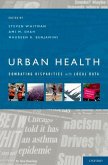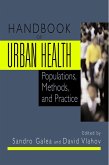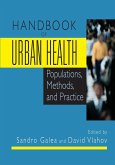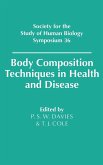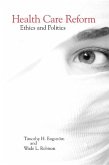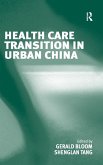M. Schell / Malcolm Smith / Alan Bilsborough (eds.)
Urban Ecology Health in Third
Herausgeber: Schell, Lawrence M.; Bilsborough, Alan; Smith, Malcolm T.
M. Schell / Malcolm Smith / Alan Bilsborough (eds.)
Urban Ecology Health in Third
Herausgeber: Schell, Lawrence M.; Bilsborough, Alan; Smith, Malcolm T.
- Gebundenes Buch
- Merkliste
- Auf die Merkliste
- Bewerten Bewerten
- Teilen
- Produkt teilen
- Produkterinnerung
- Produkterinnerung
This volume explores the factors in Third World cities that affect human biology and health.
Andere Kunden interessierten sich auch für
![Urban Ecology and Health in the Third World Urban Ecology and Health in the Third World]() Urban Ecology and Health in the Third World67,99 €
Urban Ecology and Health in the Third World67,99 €![Urban Health Urban Health]() Steven WhitmanUrban Health144,99 €
Steven WhitmanUrban Health144,99 €![Handbook of Urban Health Handbook of Urban Health]() Sandro Galea / David Vlahov (eds.)Handbook of Urban Health188,99 €
Sandro Galea / David Vlahov (eds.)Handbook of Urban Health188,99 €![Handbook of Urban Health Handbook of Urban Health]() Handbook of Urban Health90,99 €
Handbook of Urban Health90,99 €![Body Composition Techniques in Health and Disease Body Composition Techniques in Health and Disease]() S. W. Davies / J. Cole (eds.)Body Composition Techniques in Health and Disease177,99 €
S. W. Davies / J. Cole (eds.)Body Composition Techniques in Health and Disease177,99 €![Health Care Reform: Ethics and Politics Health Care Reform: Ethics and Politics]() Timothy H. Engström / Wade L. Robison (eds.)Health Care Reform: Ethics and Politics126,99 €
Timothy H. Engström / Wade L. Robison (eds.)Health Care Reform: Ethics and Politics126,99 €![Health Care Transition in Urban China Health Care Transition in Urban China]() Shenglan TangHealth Care Transition in Urban China122,99 €
Shenglan TangHealth Care Transition in Urban China122,99 €-
-
-
This volume explores the factors in Third World cities that affect human biology and health.
Hinweis: Dieser Artikel kann nur an eine deutsche Lieferadresse ausgeliefert werden.
Hinweis: Dieser Artikel kann nur an eine deutsche Lieferadresse ausgeliefert werden.
Produktdetails
- Produktdetails
- Verlag: Cambridge University Press
- Seitenzahl: 304
- Erscheinungstermin: 31. März 2008
- Englisch
- Abmessung: 235mm x 157mm x 22mm
- Gewicht: 647g
- ISBN-13: 9780521411592
- ISBN-10: 0521411599
- Artikelnr.: 23818842
- Herstellerkennzeichnung
- Libri GmbH
- Europaallee 1
- 36244 Bad Hersfeld
- gpsr@libri.de
- Verlag: Cambridge University Press
- Seitenzahl: 304
- Erscheinungstermin: 31. März 2008
- Englisch
- Abmessung: 235mm x 157mm x 22mm
- Gewicht: 647g
- ISBN-13: 9780521411592
- ISBN-10: 0521411599
- Artikelnr.: 23818842
- Herstellerkennzeichnung
- Libri GmbH
- Europaallee 1
- 36244 Bad Hersfeld
- gpsr@libri.de
1. Human biological approaches to the study of Third World urbanism; 2.
Social and cultural influences in the risk of cardiovascular disease in
urban Brazil; 3. The urban disadvantage in the developing world and the
physical and mental growth of children; 4. Differences in endocrine status
associated with urban-rural patterns of growth and maturation in Bundi
(Gende speaking) adolescents of Papua New Guinea; 5. Nutritionally
vulnerable households in the urban slum economy: a case study from Khulna,
Bangladesh; 6. Urban-rural differences in growth and diarrhoeal morbidity
of Filipino infants; 7. Child health and growth in urban South Africa;
8. From countryside to town in Morocco: ecology, culture and public health;
9. Urban-rural population research: a town like Alice; 10. Selection for
rural-to-urban migrants in Guatemala; 11. Health and nutrition in Mixtec
Indians; 12. Urban health and ecology in Bunia, N-E Zaire, with special
reference to the physical development of children; 13. Food for thought:
meeting a basic need for low income urban residents; 14. Immunological
parameters in north-east Arnhem Land Aborigines: consequences of changing
settlement patterns and lifestyles; 15. Amerindians and the price of
modernization; 16. Sex ratio determinants in Indian populations: studies at
national, state and district levels; 17. Polarization and depolarization in
Africa; 18. Urbanization in the Third World: health policy implications;
Index.
Social and cultural influences in the risk of cardiovascular disease in
urban Brazil; 3. The urban disadvantage in the developing world and the
physical and mental growth of children; 4. Differences in endocrine status
associated with urban-rural patterns of growth and maturation in Bundi
(Gende speaking) adolescents of Papua New Guinea; 5. Nutritionally
vulnerable households in the urban slum economy: a case study from Khulna,
Bangladesh; 6. Urban-rural differences in growth and diarrhoeal morbidity
of Filipino infants; 7. Child health and growth in urban South Africa;
8. From countryside to town in Morocco: ecology, culture and public health;
9. Urban-rural population research: a town like Alice; 10. Selection for
rural-to-urban migrants in Guatemala; 11. Health and nutrition in Mixtec
Indians; 12. Urban health and ecology in Bunia, N-E Zaire, with special
reference to the physical development of children; 13. Food for thought:
meeting a basic need for low income urban residents; 14. Immunological
parameters in north-east Arnhem Land Aborigines: consequences of changing
settlement patterns and lifestyles; 15. Amerindians and the price of
modernization; 16. Sex ratio determinants in Indian populations: studies at
national, state and district levels; 17. Polarization and depolarization in
Africa; 18. Urbanization in the Third World: health policy implications;
Index.
1. Human biological approaches to the study of Third World urbanism; 2.
Social and cultural influences in the risk of cardiovascular disease in
urban Brazil; 3. The urban disadvantage in the developing world and the
physical and mental growth of children; 4. Differences in endocrine status
associated with urban-rural patterns of growth and maturation in Bundi
(Gende speaking) adolescents of Papua New Guinea; 5. Nutritionally
vulnerable households in the urban slum economy: a case study from Khulna,
Bangladesh; 6. Urban-rural differences in growth and diarrhoeal morbidity
of Filipino infants; 7. Child health and growth in urban South Africa;
8. From countryside to town in Morocco: ecology, culture and public health;
9. Urban-rural population research: a town like Alice; 10. Selection for
rural-to-urban migrants in Guatemala; 11. Health and nutrition in Mixtec
Indians; 12. Urban health and ecology in Bunia, N-E Zaire, with special
reference to the physical development of children; 13. Food for thought:
meeting a basic need for low income urban residents; 14. Immunological
parameters in north-east Arnhem Land Aborigines: consequences of changing
settlement patterns and lifestyles; 15. Amerindians and the price of
modernization; 16. Sex ratio determinants in Indian populations: studies at
national, state and district levels; 17. Polarization and depolarization in
Africa; 18. Urbanization in the Third World: health policy implications;
Index.
Social and cultural influences in the risk of cardiovascular disease in
urban Brazil; 3. The urban disadvantage in the developing world and the
physical and mental growth of children; 4. Differences in endocrine status
associated with urban-rural patterns of growth and maturation in Bundi
(Gende speaking) adolescents of Papua New Guinea; 5. Nutritionally
vulnerable households in the urban slum economy: a case study from Khulna,
Bangladesh; 6. Urban-rural differences in growth and diarrhoeal morbidity
of Filipino infants; 7. Child health and growth in urban South Africa;
8. From countryside to town in Morocco: ecology, culture and public health;
9. Urban-rural population research: a town like Alice; 10. Selection for
rural-to-urban migrants in Guatemala; 11. Health and nutrition in Mixtec
Indians; 12. Urban health and ecology in Bunia, N-E Zaire, with special
reference to the physical development of children; 13. Food for thought:
meeting a basic need for low income urban residents; 14. Immunological
parameters in north-east Arnhem Land Aborigines: consequences of changing
settlement patterns and lifestyles; 15. Amerindians and the price of
modernization; 16. Sex ratio determinants in Indian populations: studies at
national, state and district levels; 17. Polarization and depolarization in
Africa; 18. Urbanization in the Third World: health policy implications;
Index.

